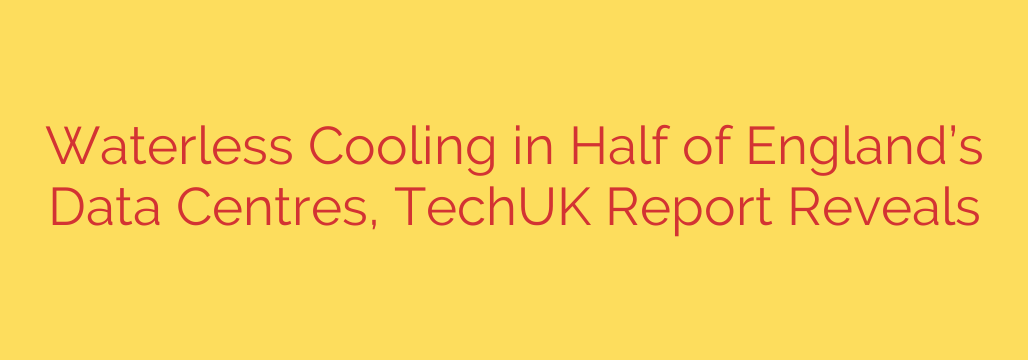
England’s Data Centers Embrace Sustainability: Nearly Half Now Use Waterless Cooling
Data centers are the invisible engines of our digital world, powering everything from cloud computing and streaming services to artificial intelligence. However, their immense processing power has historically come at a significant environmental cost, particularly regarding energy and water consumption. A common image is of massive facilities using vast quantities of water for cooling.
New data, however, reveals a significant and encouraging shift in how these critical facilities operate. A landmark analysis shows that the data center industry in England is making major strides in water conservation, challenging outdated perceptions and setting a new standard for sustainable digital infrastructure.
The Surprising Shift to Waterless Cooling
The most compelling finding is that nearly half (47%) of all data centers in England now operate without using water for cooling. Instead of relying on traditional water-intensive evaporative cooling methods, these facilities primarily use direct air cooling systems that leverage ambient air to manage temperatures.
This move towards waterless technology is not just limited to smaller operators. In fact, the trend is most pronounced among larger, more powerful facilities. The data reveals that these waterless data centers account for an astonishing 61% of the nation’s total IT capacity. This indicates that the industry’s biggest players are leading the charge in adopting more sustainable and efficient cooling solutions, a crucial step in reducing the sector’s overall environmental footprint.
Putting Water Consumption into Context
While nearly half of the facilities are waterless, what about the rest? The report also provides critical context for the industry’s total water usage. It’s estimated that data centers across England consume approximately 1.76 million cubic meters of water annually.
While that number sounds large, it represents a surprisingly small fraction of the country’s overall usage. In fact, data center water consumption accounts for just 0.04% of England’s total public water supply. This context is vital, as it demonstrates that while water conservation is a key priority, the sector’s current impact is far smaller than often portrayed in public discourse. The industry’s proactive shift towards air-cooling technologies is set to reduce this figure even further.
What is Driving the Move to Sustainable Cooling?
This transition isn’t happening by accident. Several key factors are accelerating the adoption of water-efficient technologies like direct air cooling:
- Climate Suitability: The UK’s temperate climate is ideal for direct air cooling, which is most effective in environments without extreme heat. This gives operators in the region a natural advantage in pursuing waterless designs.
- Operational Efficiency: Modern air-cooling systems are incredibly efficient, helping to lower a facility’s Power Usage Effectiveness (PUE)—a key metric for energy performance. By reducing reliance on water, operators also cut costs associated with water purchasing, treatment, and pumping.
- Environmental Responsibility: As businesses and their customers become more environmentally conscious, sustainability has become a competitive differentiator. Data center operators are investing in green technologies to meet corporate social responsibility goals and attract clients who prioritize sustainability.
- Regulatory Foresight: With increasing scrutiny on water resources, the industry is proactively adapting to future-proof its operations against potential water usage regulations and scarcity issues.
Actionable Steps for a Greener Digital Future
This report highlights a positive trend, but the work is far from over. Both data center operators and the businesses that rely on them can take steps to further promote sustainability.
For Data Center Operators:
- Prioritize Water Usage Effectiveness (WUE): Alongside PUE, track and optimize WUE as a core performance metric.
- Invest in Modernization: For older facilities still using less efficient cooling, explore retrofitting with modern, hybrid, or direct air-cooling systems.
- Increase Transparency: Publicly report on water and energy consumption to build trust and demonstrate a commitment to sustainability.
For Businesses Choosing a Data Center Provider:
- Ask the Right Questions: Inquire about a provider’s cooling methods, PUE, and WUE metrics.
- Review Sustainability Reports: Choose partners who are transparent about their environmental impact and have clear goals for improvement.
- Prioritize Green Providers: Make sustainability a key factor in your procurement process. Supporting environmentally responsible data centers drives the entire industry forward.
Ultimately, the data shows a mature and responsible industry actively working to solve its environmental challenges. The significant move toward waterless cooling is a testament to the innovation happening behind the scenes, ensuring that our digital future is built on a foundation that is both powerful and sustainable.
Source: https://datacentrereview.com/2025/08/half-of-englands-data-centres-now-use-waterless-cooling-techuk-report-finds/








